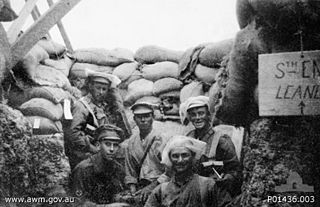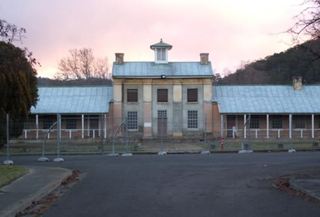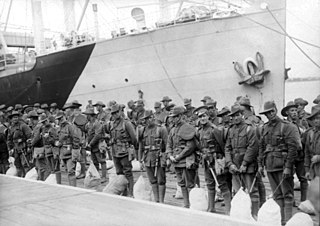Derwent Barracks is an Australian Army barracks in the Hobart suburb of Glenorchy, near the Elwick Racecourse and Hobart Showgrounds. It is the home of several Army Reserve units including:

The Australian Army is Australia's military land force. It is part of the Australian Defence Force (ADF) along with the Royal Australian Navy and the Royal Australian Air Force. While the Chief of the Defence Force (CDF) commands the ADF, the Army is commanded by the Chief of Army (CA). The CA is therefore subordinate to the CDF, but is also directly responsible to the Minister for Defence. Although Australian soldiers have been involved in a number of minor and major conflicts throughout its history, only in World War II has Australian territory come under direct attack.

Hobart is the capital and most populous city of the Australian island state of Tasmania. With a population of approximately 225,000, it is the least populated Australian state capital city, and second smallest if territories are taken into account. Founded in 1804 as a British penal colony, Hobart, formerly known as Hobart Town or Hobarton, is Australia's second oldest capital city after Sydney, New South Wales. Prior to British settlement, the Hobart area had been occupied for possibly as long as 35,000 years, by the semi-nomadic Mouheneener tribe, a sub-group of the Nuennone, or South-East tribe. The descendants of these Aboriginal Tasmanians often refer to themselves as 'Palawa'.

Glenorchy City is bound by the Derwent River on the Eastern side, Mount Wellington on the Western side, Hobart City to the South and Brighton to the North. The Glenorchy CBD is the focal point for retail, doctors and government services. The land was originally used for agriculture but is now a largely suburban, working class area, that grew quickly after WWII as returning soldiers settle in State Government Housing suburbs. The city officially begins at Creek Road Newtown, in Hobart's northern suburbs, and includes, Moonah, Derwent Park, Lutana, Goodwood, Chigwell, Claremont and Austins ferry. It is the seat of the local government area of the same name, the City of Glenorchy.
- 12th/40th Battalion Royal Tasmania Regiment, [1]
- Army Financial Services Unit - Southern Region
- 16th Field Battery, and
- 2nd Force Support Battalion. [2]

The Royal Tasmania Regiment is a Reserve infantry regiment within the Australian Army consisting of a single battalion. Formed in 1960 following a review of military formations in Australia, the Regiment can trace its lineage back the late 19th Century and has served Australia in a number of conflicts including the Boer War, World War I and World War II. Today it serves as a part of the Australian Army's 9th Brigade, 2nd Division.
The 16th Field Battery was an Australian Army Reserve unit based in Tasmania with depots at Paterson Barracks in Launceston and Derwent Barracks in Hobart until 2013, when it was reduced in size to a troop, and amalgamated with its Adelaide-based sister battery, 48 Field Battery, to form the 6th/13th Light Battery. The unit is the longest continually serving reserve artillery unit in the Australian Army.
The 2nd Force Support Battalion is an Australian Army logistics battalion. Established in 1998, 2 FSB is a Reserve unit headquartered in Hobart, with depot in various locations across Tasmania and Victoria.
Other facilities:
- Joint Logistic Unit Victoria (JLUV) Hobart Detachment,
- Area Clothing Store,
- Anglesea Barracks Officers Mess (ABOM) Derwent Barracks Annex,
- Sergeants Mess Annex, and
- Griffins Lair (Soldiers Club).

Anglesea Barracks is an Australian Defence Force barracks in central Hobart, Tasmania. The site was chosen in December 1811 by Lachlan Macquarie and construction began on the first buildings to occupy the site in 1814. It is the oldest Australian Army barracks still in use and celebrated its bicentenary in December 2011.











